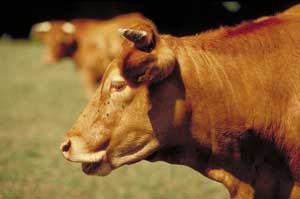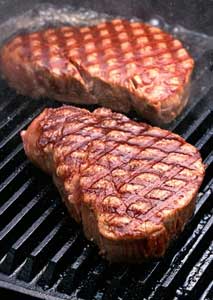
Taking A Critical
Look At Meat
The average American consumes 607 pounds of animal products each year. In one’s lifetime that includes: 21 cows, 14 sheep, 12
hogs, 900 chickens, and 1,000 pounds of other animals, that either swam in the ocean, or flew in the air. Animal muscle tissue
disappears down American throats
by the metric ton each year.
ANIMAL Products
Are Big Business
There are now about 100 million
cows in the United States, nearly
one cow for every two and a half
Americans. Cows are everywhere.
In the United States some 100
thousand cows are slaughtered
every twenty four hours. Most
people in the united States have
been trained from an early age
to gorge on beef. Children
less that seven years of age eat
an average of1.7 hamburgers
per week and by the time they
reach the age of 13, they eat
6.2 hamburgers per week.
More than 6.7 billion hamburgers
are sold to Americans each year
at fast food restaurants alone,
in fact every second, 200
Americans purchase one or
more hamburgers at fast-food
outlets, resulting in billions of
dollars of revenue for American
restaurant chains.
This popular food item (ground
beef), is loaded with additives and
legal extenders. It may be adulterated with coal-tar colors, cochineal(a brilliant red dye made by drying and pulverizing the bodies of the females of a tropical American insect), and sodium nitrate or benzoate of soda. Sodium sulfite, another additive, can mask the smell of deteriorating meat, and give it a fresh-meat red color. Sodium sulfite is a poison that destroys vitamin B1, and is capable of causing considerable
damage to the digestive system
and other organs. Yet tested
samples of ground beef
purchased as ready-chopped
hamburger, are sold at hot
dog stands, cafeterias, and
restaurants, frequently shows
adulteration with this chemical.
Hamburger meat served in
restaurants often contains
sodium nicotinate to preserve
it bright red color. Although
this chemical is illegal in some
municipalities, 37 states permit
its use. Several outbreaks of
poisoning have been traced
to this additive.
Antibiotics In You Meat
Of what American consumers
ate, and called food, in 1974 a
billion pounds were pure chemicals
—food additives. That amounts
to more than five pounds per
person. And this figure has
increased greatly in the past
twenty years.
In order to raise the animals
more quickly, shorten the
feeding time, and hasten
marketing to maximize profits,
animals are fed hormone
preparations causing them
to gain weight and grow
quickly. In 1970, approximately
1,300 tons of antibiotics
were fed to animals in the
United States alone. Today,
about 99% of all animal feed
contains additives.
According to the World Health
Organization booklet Public Health Aspects of the Use Of Antibiotics in Food and Foodstuffs, published in 1963, antibiotics are now used to preserve fish and poultry. Chickens are dipped in solutions of the drug following slaughter. Fish can be thrown into a tub of antibiotic solution as soon as they are caught, or the fillets can be washed with the drug. Steers are sometimes injected with antibiotics just before they are slaughtered.
Many of the drugs and
antibiotics used leave dangerous
residues in animal products if they
are not depleted from the animals
before slaughter or before milk is
collected. In all, there are more
than 1,000 drug products, and as
many chemicals, approved by the
Food and Drug Administration
that can be used by livestock and
poultry producers. Farm industry
and pro-farming government
officials downplay the risk, arguing that drugs and chemicals are rigorously tested before they are put into commercial use.
And yet according to a recent
report put out by the General
Accounting Office, 14 percent
of all meat and poultry sampled
by the department of Agriculture
between 1974 and 1976 contained
illegally high levels of drugs and
pesticides. The report notes that
many of the substances used
around food animals are known
to be dangerous.
Bacteria In Meat—
Same As Fresh Manure?
Another serious problem with
meat eating is the putrefactive
bacteria in meat. The average
eater of meat is quite unconscious
of the fact that each mouthful
that enters the body he has taken
in a mass of swarming micro
organisms identical in character
with those of manure and those
found in dead rats. All meat
becomes infected with manure
germs in the process of slaughtering and the number increases the longer the meat is kept in storage.
What are putrefactive bacteria?
Putrefactive bacteria are names
used so that the layman is not
shocked. Putrefactive bacteria
are colon germs. When the animal
is alive, the osmotic process in
the colon keeps putrefactive
bacteria from getting into the
animal. In the process of
slaughtering animals their
tissue becomes thoroughly
infected with the manure
germs which are found upon
their bodies. When the animal
is dead, the osmotic process
is gone and putrefactive bacteria
swarm through the walls of the
colon and into the flesh. The
bacteria rapidly penetrates
the tissues. Within a few hours
after death, the carcass is
swarming with these filthy
intestinal bacterial. This is
what helps tenderize the meat.
Remember, putrefactive bacteria
are colon germs and colon germs
are manure germs and this is
what tenderizes meat—manure
germs!
Cancer And Meat Eating
Within the last one hundred years, meat consumption has risen four times and the per capita consumption of meat in the United States is still increasing yearly.
Diet has been linked to cancer.
There are many carcinogens in
the food and animal products
that are consumed by most
Americans today.
While many of these chemicals
have been suspected of having
negative effects on health, one
in particular, sodium nitrite
has the dubious distinction
of possibly being fatal.
More important, studies now
link nitrites in the diet with
the development of cancer
in laboratory animals.
Nitrites are used specifically
in hot dogs, ham, bacon,
luncheon meat and similar
products.
UNHEALTHY ANIMALS
An average of 10 to 30 percent
of beef livers at slaughterhouses
are condemned because of abscesses. USDA records showed that during a one year period, Americans ate millions of pounds of beef from cattle that had “cancer eye” or similar tumorous disorders. The diseased parts were merely cut out and the remainder
of the carcass was permitted
to be marketed. Agriculture
officials claim that such localized
tumors pose no threat to human
beings eating meat from other
portions of such animals. A
government report showed that
more than 10 percent of the 30.1
million cattle carcasses approved
by federal inspection underwent
some post-mortem cutting for
removal of some diseased part.
Another report showed that
2,400,000 cattle whose cancerous
or tubercular livers were on to
be processed for food.
More Reasons For
Not Eating Meat
- Blood Pressure—When meat was added to the diets of vegetarians their blood pressure was elevated after 11 days.
- A follow-up in European studies with the elderly showed a drop of blood pressure to within normal range after
- 2 months when they were put back on a vegetarian diet.
- Difficult to Digest—All animal protein is difficult to digest. One of the main reasons is because man does not secrete
- the uricase enzyme that meat-eating animals do.
- Meat then becomes putrefactive.
- Meat can take up to 60-100
- hours to digest whereas normal
- digestion takes only about 24-30 hours.
- Uric Acid—The flavor in meat is partly due to the presence of uric acid which is the major cause of gout.
- Uric acid is a purine, a toxic waste that is poisonous to living tissues.
- When not promptly and thoroughly removed from the blood by the kidneys, it will
- be deposited in the tissues which then can give rise to gout and can also cause kidney and bladder stones.
- Poisonous Waste—Meat contains considerable quantities of the end
- products of cell metabolism.
- These are in the tissues at death and continue to build up until the cells cease functioning. These wastes are poisonous. Instead of giving added strength as many believe, these give meat a stimulating property identical to that in caffeine, alcohol, vinegar, or any other drug.
- Over 10 Times The Pesticide—Meat products contain over ten times as much pesticide as commercially-
- sprayed fruits and vegetables because these chemicals are stored in the animals body tissue over the course of its life, and become more and more concentrated.
- Meat lacks Fiber—Meat lacks fiber which is abundantly found in fruits, vegetables, nuts, and grains.
- A high meat diet results in constipation, with hard and infrequent stools because of the lack of fiber.
- Meat is High In Saturated Fats— the fat found in all animals except fish, and in dairy products is high in saturated fat.
- Fats in the diet can raise the blood cholesterol and speed-up the development of hardening of the arteries by the process of the number-one and number-three killers in this country, but are only miner causes of death in countries where there is little or no meat in the diet.
- Cows are Fed Offal, Manure,
- Restaurant Waste, and Other
- Unsavory Materials.
- Scott Williams, Executive Director of the Farm Animal Reform Movement (FARM) said:
- “Animal agriculture is a grisly, grisly business. You may imagine a contented cow chewing its cud, but the cow is more likely being fattened on the intestines of its slaughtered comrades”
Few meat eaters would like to hear the words putrefaction, rigor mortis, and rotting flesh applied to their sirloin and pot roast. But flesh is flesh, though the euphemisms, ripening,
toughening, and enzymatic action are kinder to the ear.
Vic Sussman, The Vegetarian Alternative.
Whether therefore ye eat, or drink, or whatsoever ye do, do all to the glory of God.
1Corinthians10:31
Katy Chamberlin,
Box 1540, Grants Pass,
Oregon, 97528
